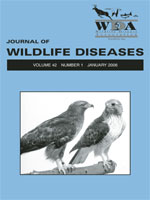Nebraska's Rainwater Basin (RWB) is a key spring migration area for millions of waterfowl and other avian species. Avian cholera has been endemic in the RWB since the 1970s and in some years tens of thousands of waterfowl have died from the disease. We evaluated patterns of avian cholera mortality in waterfowl species using the RWB during the last quarter of the 20th century. Mortality patterns changed between the years before (1976–1988) and coincident with (1989–1999) the dramatic increases in lesser snow goose abundance and mortality. Lesser snow geese (Chen caerulescens caerulescens) have commonly been associated with mortality events in the RWB and are known to carry virulent strains of Pasteurella multocida, the agent causing avian cholera. Lesser snow geese appeared to be the species most affected by avian cholera during 1989–1999; however, mortality in several other waterfowl species was positively correlated with lesser snow goose mortality. Coincident with increased lesser snow goose mortality, spring avian cholera outbreaks were detected earlier and ended earlier compared to 1976–1988. Dense concentrations of lesser snow geese may facilitate intraspecific disease transmission through bird-to-bird contact and wetland contamination. Rates of interspecific avian cholera transmission within the waterfowl community, however, are difficult to determine.
How to translate text using browser tools
1 January 2006
MULTI-SPECIES PATTERNS OF AVIAN CHOLERA MORTALITY IN NEBRASKA'S RAINWATER BASIN
Julie A. Blanchong,
Michael D. Samuel,
Gene Mack

Journal of Wildlife Diseases
Vol. 42 • No. 1
January 2006
Vol. 42 • No. 1
January 2006
avian cholera
Chen caerulescens caerulescens
epizootiology
lesser snow geese
Nebraska
Pasteurella multocida
Rainwater Basin




